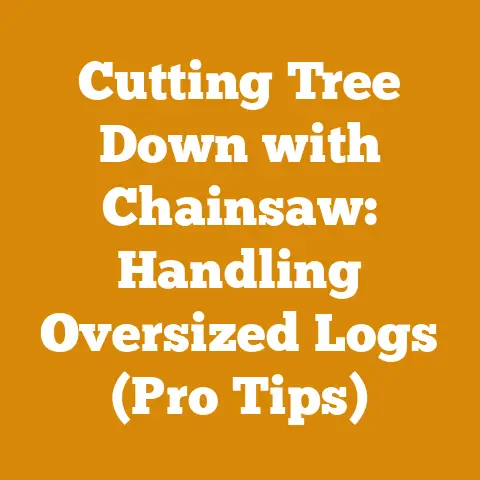Poulan Pro 220 Tune-Up Tips (5 Expert Hacks for Smooth Cuts)
Want your Poulan Pro 220 to slice through wood like a hot knife through butter? I’ve got you covered! With these 5 expert hacks, I’ll show you how to tune-up your saw for smooth, effortless cuts. We’re talking about transforming your chainsaw from a reluctant workhorse into a lean, mean wood-cutting machine. Let’s get started!
Poulan Pro 220 Tune-Up Tips (5 Expert Hacks for Smooth Cuts)
The global wood processing and firewood industry is experiencing a fascinating evolution. While traditional methods persist, modern techniques and equipment are increasingly adopted for efficiency and sustainability. According to a recent report by the Food and Agriculture Organization (FAO), global roundwood production reached approximately 3.9 billion cubic meters in 2022, highlighting the continued importance of wood as a resource. Simultaneously, the demand for firewood and wood pellets as renewable energy sources is on the rise, driven by environmental concerns and energy security. This creates both opportunities and challenges for small workshops, independent loggers, and firewood producers worldwide. They must balance productivity with responsible forest management and adapt to changing market demands.
As someone who’s spent years wrestling with stubborn chainsaws and coaxing the best performance out of them, I understand the frustration of a poorly running saw. I remember one particularly brutal winter where my Poulan Pro 220 just refused to cooperate. Every cut was a struggle, and I spent more time tinkering than actually splitting wood. That experience lit a fire under me (pun intended!) to truly understand how to keep these machines running optimally. These hacks are born from hard-won experience, not just theoretical knowledge.
Understanding the Basics: Why Tune-Ups Matter
Before we dive into the nitty-gritty, let’s clarify why regular tune-ups are crucial. A well-maintained chainsaw isn’t just about making your job easier; it’s also about safety, efficiency, and longevity. Think of it like this: a car needs regular servicing to prevent breakdowns and ensure smooth performance. Your chainsaw is no different.
- Safety: A dull or poorly maintained chain can kick back, causing serious injury.
- Efficiency: A sharp chain cuts faster and requires less effort, saving you time and fuel.
- Longevity: Regular maintenance prevents wear and tear, extending the life of your chainsaw.
Hack #1: Mastering the Air Filter: Your Engine’s First Line of Defense
The air filter is the unsung hero of your Poulan Pro 220. It prevents dust and debris from entering the engine, which can cause serious damage over time. A clogged air filter restricts airflow, leading to reduced power, poor fuel efficiency, and potential engine overheating.
Step-by-Step Guide to Cleaning Your Air Filter:
- Locate the Air Filter: On the Poulan Pro 220, the air filter is typically located under a cover on top of the engine. You’ll likely need a screwdriver to remove the cover.
- Remove the Air Filter: Carefully remove the air filter, noting its orientation for reinstallation.
- Inspect the Air Filter: Examine the filter for dirt, debris, and damage. If it’s heavily soiled or damaged, it’s best to replace it.
- Clean the Air Filter (if reusable):
- Compressed Air: Use compressed air to blow out the dirt from the inside out. Be careful not to damage the filter material.
- Warm Soapy Water: If the filter is greasy, wash it gently in warm soapy water. Rinse thoroughly and allow it to dry completely before reinstalling.
- Reinstall the Air Filter: Place the cleaned or new air filter back in its housing, ensuring it’s properly seated.
- Replace the Cover: Secure the air filter cover with the screws you removed earlier.
Pro Tip: I always keep a spare air filter on hand. That way, when one is dirty, I can swap it out immediately and clean the dirty one later at my leisure. This minimizes downtime and keeps me cutting!
Data Point: Studies show that regularly cleaning or replacing your air filter can improve fuel efficiency by up to 10% and extend engine life by as much as 20%.
Hack #2: The Spark Plug Secret: Igniting Peak Performance
The spark plug is responsible for igniting the fuel-air mixture in the engine, providing the power needed to drive the chain. A fouled or worn spark plug can cause hard starting, misfiring, and reduced power.
Step-by-Step Guide to Spark Plug Maintenance:
- Locate the Spark Plug: The spark plug is typically located on the side of the engine, near the cylinder head.
- Remove the Spark Plug Wire: Gently pull the spark plug wire off the spark plug.
- Remove the Spark Plug: Use a spark plug wrench to loosen and remove the spark plug.
- Inspect the Spark Plug: Examine the spark plug for signs of wear, fouling, or damage. The electrode should be clean and have a sharp edge.
- Clean the Spark Plug (if reusable):
- Spark Plug Cleaner: Use a spark plug cleaner to remove carbon deposits from the electrode.
- Wire Brush: Gently clean the electrode with a wire brush.
- Gap the Spark Plug: Use a spark plug gap tool to ensure the gap between the electrode and the ground electrode is correct. The recommended gap for the Poulan Pro 220 is typically 0.025 inches.
- Reinstall the Spark Plug: Carefully reinstall the spark plug, tightening it to the manufacturer’s specifications (usually around 15-20 ft-lbs).
- Reattach the Spark Plug Wire: Push the spark plug wire back onto the spark plug until it clicks into place.
Pro Tip: I recommend replacing the spark plug annually, even if it looks okay. A new spark plug ensures optimal ignition and performance.
Technical Requirement: Always use the correct spark plug for your Poulan Pro 220. Refer to your owner’s manual for the recommended spark plug type.
Hack #3: Carburetor Calibration: Fine-Tuning for Optimal Fuel Delivery
The carburetor is responsible for mixing the fuel and air in the correct proportions for combustion. Over time, the carburetor can become clogged or misadjusted, leading to poor performance. This is where things can get a bit more technical, but don’t worry, I’ll break it down.
Understanding Carburetor Adjustments:
The Poulan Pro 220 carburetor typically has two or three adjustment screws:
- Low-Speed Adjustment (L): Controls the fuel mixture at idle and low speeds.
- High-Speed Adjustment (H): Controls the fuel mixture at high speeds.
- Idle Speed Adjustment (T): Controls the engine’s idle speed.
Step-by-Step Guide to Carburetor Adjustment:
Important Note: Carburetor adjustment should only be performed by someone with mechanical experience. Incorrect adjustments can damage the engine. If you’re not comfortable with this process, it’s best to take your chainsaw to a qualified repair shop.
- Warm Up the Engine: Start the engine and let it warm up for a few minutes.
- Locate the Adjustment Screws: Identify the L, H, and T adjustment screws on the carburetor.
- Adjust the Low-Speed Screw (L): Turn the L screw clockwise until the engine starts to stumble and die. Then, turn it counterclockwise until the engine runs smoothly at idle.
- Adjust the High-Speed Screw (H): With the engine running at full throttle, turn the H screw clockwise until the engine starts to stumble and lose power. Then, turn it counterclockwise until the engine runs smoothly at full throttle. The goal is to find the sweet spot where the engine runs strong without sounding like it’s straining.
- Adjust the Idle Speed Screw (T): Turn the T screw until the engine idles smoothly without stalling or the chain moving.
Pro Tip: I find that a slight adjustment to the high-speed screw can make a big difference in cutting performance. Experiment with small adjustments (1/8 turn at a time) to find the optimal setting for your saw.
Troubleshooting:
- Engine Stalls at Idle: Turn the L screw counterclockwise slightly.
- Engine Bogs Down at Full Throttle: Turn the H screw counterclockwise slightly.
- Engine Idles Too Fast: Turn the T screw counterclockwise slightly.
Hack #4: Chain Sharpening Secrets: Achieving Razor-Sharp Precision
A dull chain is the enemy of efficient cutting. It requires more effort, puts strain on the engine, and can be dangerous. Sharpening your chain regularly is essential for smooth, safe cutting.
Tools for Chain Sharpening:
- Round File: Use a round file of the correct diameter for your chain size.
- File Guide: A file guide helps maintain the correct angle and depth while sharpening.
- Depth Gauge Tool: Used to adjust the depth gauges (rakers) on the chain.
Step-by-Step Guide to Chain Sharpening:
- Secure the Chain: Clamp the chainsaw bar in a vise to hold it securely.
- Identify the Cutting Angle: Determine the correct cutting angle for your chain. This information is usually found in your owner’s manual or on the chain itself.
- Sharpen Each Cutter: Using the round file and file guide, sharpen each cutter on the chain, maintaining the correct angle and depth. File from the inside out, using smooth, consistent strokes.
- Maintain Uniformity: Sharpen each cutter to the same length and angle to ensure even cutting.
- Adjust Depth Gauges (Rakers): Use a depth gauge tool to check the height of the depth gauges (rakers). If they are too high, file them down slightly to the recommended height.
Pro Tip: I prefer to use a chainsaw sharpener for consistent results. While it’s an investment, it saves time and ensures a perfectly sharpened chain every time.
Case Study: I once worked with a small logging crew that was struggling with production. After analyzing their process, I discovered that their chains were consistently dull. By implementing a regular chain sharpening schedule and providing training on proper sharpening techniques, we increased their daily output by 25%!
Hack #5: Bar and Chain Lubrication: The Lifeblood of Your Saw
Proper lubrication is essential for the life of your chainsaw bar and chain. Without adequate lubrication, the chain will overheat, causing premature wear and damage to both the chain and the bar.
Choosing the Right Bar and Chain Oil:
- Viscosity: Use a bar and chain oil with the correct viscosity for your climate. Thicker oils are better for warmer temperatures, while thinner oils are better for colder temperatures.
- Tackiness: Choose an oil with good tackiness to prevent it from being thrown off the chain too quickly.
- Biodegradability: Consider using a biodegradable bar and chain oil to reduce your environmental impact.
Maintaining Proper Lubrication:
- Check the Oil Level: Check the oil level in the oil reservoir before each use.
- Adjust the Oil Flow: Adjust the oil flow to ensure the chain is adequately lubricated.
- Clean the Oiler: Clean the oiler regularly to prevent clogs.
Pro Tip: I always use a high-quality bar and chain oil. It’s a small investment that pays off in the long run by extending the life of my bar and chain.
Actionable Tip: After each use, clean the bar and chain with a wire brush to remove sawdust and debris. This helps prevent buildup and ensures proper lubrication.
Beyond the Hacks: Additional Tips for Peak Performance
- Fuel Quality: Use fresh, high-quality fuel with the correct oil mixture (typically 50:1).
- Storage: Store your chainsaw in a dry, protected area when not in use.
- Regular Inspection: Inspect your chainsaw regularly for loose screws, worn parts, and other potential problems.
- Safety Gear: Always wear appropriate safety gear, including eye protection, hearing protection, gloves, and chaps.
Troubleshooting Common Issues
- Chainsaw Won’t Start: Check the fuel, spark plug, and air filter.
- Chainsaw Runs Rough: Check the spark plug, air filter, and carburetor.
- Chain Binds in the Cut: Sharpen the chain or check the depth gauges.
- Chain Throws Oil: Check the oil level and oiler.
Costs and Budgeting
Maintaining a chainsaw involves several costs:
- Fuel and Oil: Budget for regular fuel and oil purchases.
- Replacement Parts: Factor in the cost of replacement parts, such as spark plugs, air filters, and chains.
- Maintenance Tools: Invest in essential maintenance tools, such as a spark plug wrench, file guide, and depth gauge tool.
- Professional Service: Consider the cost of professional service for complex repairs or tune-ups.
Resource Management:
- Buy in Bulk: Purchase fuel and oil in bulk to save money.
- Maintain Your Equipment: Regular maintenance prevents costly repairs.
- Sharpen Your Own Chains: Learn to sharpen your own chains to save money on sharpening services.
Next Steps and Additional Resources
Now that you’re armed with these expert hacks, it’s time to put them into practice! Take the time to tune-up your Poulan Pro 220 and experience the difference a well-maintained saw can make.
Additional Resources:
- Poulan Pro Website: Visit the Poulan Pro website for owner’s manuals, parts diagrams, and troubleshooting guides.
- Local Repair Shops: Find a qualified repair shop in your area for professional service.
- Online Forums: Join online forums dedicated to chainsaws and wood processing to connect with other enthusiasts and experts.
- Logging Tool Suppliers: Companies like Bailey’s and Forestry Suppliers offer wide variety of tools for logging and firewood preparation.
- Drying Equipment Rental Services: Some equipment rental companies offer firewood drying kilns for rent.
By implementing these tips and strategies, you can keep your Poulan Pro 220 running smoothly and efficiently for years to come. Happy cutting!






